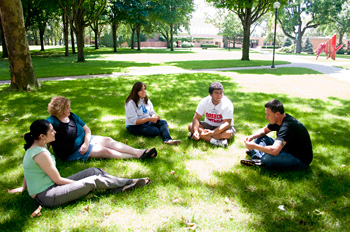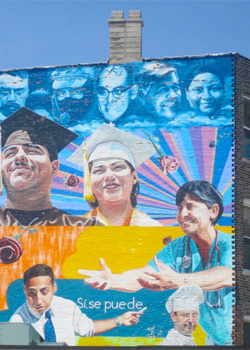Cross-cultural studying right in their own backyard

Web updates and photos from the group are available from Goshen College’s SST Web site: latino-sst.b.goshen.edu/.
GOSHEN, Ind. – Sometimes you don’t have to travel thousands of miles in an airplane over oceans to truly encounter another culture. Sometimes you just have to cross the street.
This summer, Goshen College students are participating in the 40-plus year old program Study-Service Term (SST) in Senegal, Peru, Nicaragua – and Northern Indiana. Four college students are participating in the Goshen College Latino Studies Semester in Northern Indiana, the first domestic SST location.
Ana Juarez, the director for the program, said that all four students grew up around here and this is “changing their perspectives on their community, even though it is the same place.”
Sophomore Jair Hernandez, who grew up in Goshen, said, “This program wasn’t set up to be a complete immersion. The purpose is to study a culture that is trying to integrate here. It has opened my eyes to things I wasn’t aware of before. Now I have a different perspective.”
Similar to other SST locations in places that have “significantly different” cultures, the students are studying another language, in this case Spanish. Two of the students are beginners and are learning conversational skills. The more advanced students are learning professional skills, as well as research and literature. In addition, students write weekly journal entries and work on papers and projects.
Junior Ivette Sifuentes, from Elkhart, said that she is enjoying the Spanish classes, the first she has taken as Spanish is her first language. Her teacher is correcting her grammar and helping her not to speak in Spanglish, a mixture of English and Spanish that she grew up with.
Though Hernandez and Sifuentes, as Latino students themselves, are much more familiar with the culture that they are studying this summer, “they are learning their own culture in a different way and have more appreciation for their own culture,” Juarez said. “They are learning more the reasons why different groups immigrated, as well as what people and organizations are already doing.”
Part of that learning comes from regular field trips, guest speakers and cultural events. One month the group met the Fort Wayne Hispanic Chamber of Commerce, attended a quinceanera (a 15-year-old Latina girl’s birthday party) in Michigan, toured Latino businesses in Goshen, explored Chicago’s Mexican and Puerto Rican neighborhoods, participated in an immigration rally in Indianapolis, watched folklorico dancers, heard about the immigration system from different perspectives, and traveled to Toledo, Ohio, to volunteer at a migrant workers camp.
Juarez said she is trying to introduce the students to three distinct groups of Latinos near Northern Indiana: the group in Michiana who are mostly newcomers working in the manufacturing sector, another being the long-term Latino communities with established organizations in urban Chicago, and the last being migrant workers in agricultural settings.
Like students in other study abroad locations, the students in Goshen are paired up with host families, though they meet with them weekly instead of live with them. Senior Kellyn Yoder sometimes goes shopping with her host family and is helping them paint in their new house. “It helps me put a face on the immigration issue,” she said, as she has talked with them about the possible effects of the recent changes in Arizona’s immigration laws.

In addition, the students have the opportunity to do service throughout the three-month program in a position that fits their interests. Hernandez is interested in community organizing and is working to get more Latinos involved with neighborhood associations through his service assignment with La Casa. Though he had “really wanted” to go abroad during college, he ended up deciding that he would rather “help people here where I am from.”
Yoder, an English major, is teaching English and citizenship classes at St. Mark’s United Methodist Church in Goshen. “The program offers opportunities to be more immersed than I was before,” she said. “This has been really good. I am more involved in the community now and know so much more about this place I grew up in.”
Sifuentes is translating for patients at the Center for Healing and Hope health clinic in Goshen. “I am learning more about the Latino community in Goshen,” she said. “We are going to a deeper level with people and I am seeing needs in the community and what people have to offer. … I have gained a sense of more responsibility [for my community]. As I see needs, I feel more responsible.”
Sophomore Chris Ballge is doing his service assignment at the San Jose Carniceria, where he has opportunities to interact a lot in Spanish with his coworkers and he hears customers speaking the language frequently while he shelves and stocks groceries. He had wanted to study abroad in Peru for a college cross-cultural immersion experience, but he has a family and is very involved in his church, so he couldn’t leave for three months.
Since 1968, when Goshen College was one of the first colleges in the country to require international education to graduate and began the unique semester-long SST, the college also has had the option for students unable to travel abroad – often due to life circumstances and commitments – to fulfill the requirement by taking related elective, on-campus courses. Approximately 20 percent of students take the alternative courses, which are taken when their schedule permits and are spread out over several academic years.
The impetus for the development of a domestic SST location was funding designated in the 2006 Lilly Endowment grant for the Center for Intercultural Teaching and Learning (CITL), which was created to serve the educational needs of a rapidly increasing Latino immigrant population. Minority enrollment in Northern Indiana schools – particularly of Latino students – has grown dramatically in the last 20 years.
– by Jodi H. Beyeler
Editors: For more information about this release, to arrange an interview or request a photo, contact Goshen College News Bureau Director Jodi H. Beyeler at (574) 535-7572 or jodihb@goshen.edu.
###
Goshen College, established in 1894, is a residential Christian liberal arts college rooted in the Anabaptist-Mennonite tradition. The college’s Christ-centered core values – passionate learning, global citizenship, compassionate peacemaking and servant-leadership – prepare students as leaders for the church and world. Recognized for its unique Study-Service Term program, Goshen has earned citations of excellence in Barron’s Best Buys in Education, “Colleges of Distinction,” “Making a Difference College Guide” and U.S. News & World Report’s “America’s Best Colleges” edition, which named Goshen a “least debt college.” Visit www.goshen.edu.




